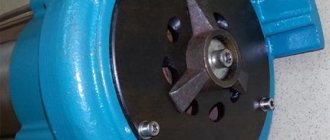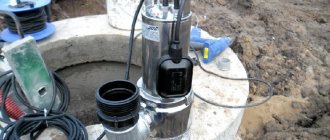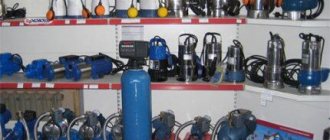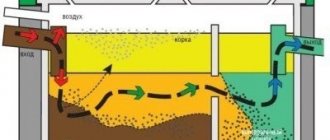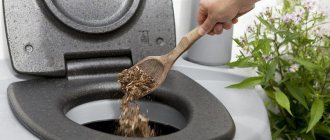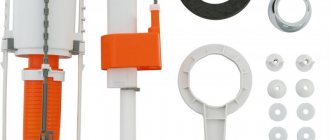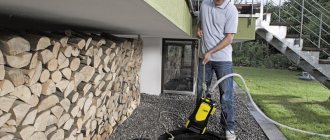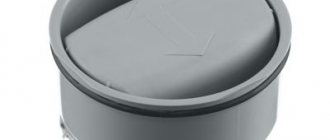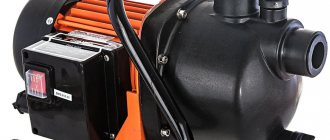A cesspool is the simplest sewer storage tank that requires periodic emptying. In order to empty the container of sediment, vacuum cleaners are usually called.
However, a fecal pump for a cesspool will also help with this task, helping to empty the storage tank on its own. Let's admit it: not all of us know which unit should be chosen for this procedure.
We have reliable information that provides answers to a wide range of questions that arise among owners of autonomous sewer systems. Using the information we provide will greatly facilitate and speed up the selection of a technical device.
The article, brought to the attention of site visitors, describes in detail the design features and operating principle of fecal pumps. The differences between the units, depending on the upcoming operating conditions, are indicated. To help the buyer, ratings of popular models, photos and video reviews are provided.
Choosing the right pump
When installing a sewer system, it is necessary to remember the inevitability of removing accumulated solid waste. To do this, use a sewer machine or clean the container yourself. A sewage pump is the right solution.
It is necessary to select equipment based on technical parameters and operating conditions. The fecal pump can be:
- superficial;
- semi-submersible;
- submersible
There are several varieties of each type of device from different manufacturers.
By marking you can determine the purpose of the drainage apparatus. If all markings include only digital parameters, the drainage pump can pump wastewater with suspended particles less than 5 mm. If the letter F is present, the pump is fecal and copes with pumping the solid fraction and long fibers. If the marking contains the letter H, the device is stable when operating in an aggressive environment. The store manager will help you choose the right fecal pump for drainage.
The pump is selected for pumping wastewater through a long gravity system to the receiving collector of the general sewer system, more often for pumping VOCs.
Advantages and disadvantages of fecal pumps with a grinder
The advantages of the model are determined by its design and operating conditions. Submersible models are capable of lifting liquid from great depths; if there is a control float, they operate in automatic mode; additional cooling is not required, since the device is located in the waste layer and does not overheat and does not make noise. There are practically no disadvantages if expensive equipment made from durable materials is purchased.
Advantages of semi-submersible models:
- low cost;
- repairs are cheaper;
- no need for waterproofing.
Disadvantages - shallow depth, inability to pump large particles, since it is not possible to install a grinder.
The disadvantage of surface fecal pumps is cavitation: if the depth is greater than that indicated in the instructions, air gets into the liquid and the motor stops or burns out, so they are used only for shallow septic tanks. Also, surface equipment is bulky and noisy. The advantage is mobility, the ability to be used for all household needs.
Selection of submersible pumps for pumping out wastewater
When working in an aggressive liquid environment, the device must be sealed and resistant to corrosion. Therefore, the fecal submersible pump is made of resistant materials - cast iron, stainless steel or polymers.
Based on the principle of operation, devices are distinguished:
Experts consider the centrifugal pump to be the most efficient and reliable.
The device is equipped with a filter mesh on the suction pipe, a check valve, and an automatic switching system at a certain level in the tank. Often, a fecal pump is used with a grinder and installed on a wide substrate so that it does not get sucked into the sludge bottom sediments.
Advantages of submersible type devices:
- pumps waste with a solid fraction with a cross-section of 80 mm;
- reliability in operation, do not break down in a specific environment;
- do not overheat in a liquid environment;
- creates a pressure of up to 30 m;
- pumps with grinders pump waste in a pipe with a cross-section of 50 mm, saving money when installing a pressure pipeline.
Manufacturers of the installations are well-known companies.
Let us give examples of inexpensive fecal pumps and their features.
- Caliber NPC-1350 represents a budget version of a submersible drainage fecal pump. The device has a shredder that is capable of passing 18 m 3 of waste. In this case, the device is capable of passing a maximum piece size of 40 mm. The pump creates a pressure of 12 meters, convenient for use in local systems. The cost of the device is 5-8 thousand rubles and is affordable for people with low incomes.
- The FN-750 vortex operates at a depth of up to 9 meters. A head of 13 meters allows you to lift waste from a low level. The pump does not have a grinder, but does have a float start system. The device is capable of passing solid waste up to 42 mm in size. The device has overheating protection. The price of the pump is 6-7 thousand rubles.
- The Hungarian Eipumps device can be used in everyday life and for pumping out industrial wastewater, depending on the modification. An economical, reliable device, not inferior in performance to domestic models, costs from 4 thousand rubles.
- Gilex Fekalnik - the unit from the Russian plant is produced in a plastic case or made of stainless steel. The capacity of the fecal pump for cesspools is 9-15 m 3, the pressure is 11 meters, which is enough for a local system. Depending on the design of the case, the cost on average is about 5 thousand rubles.
- HeizWRS 25 is a German designed pump, made in China. The device is equipped with a chopper; with a pressure of up to 14 meters, its consumption can be up to 15 m 3 /hour. Energy consumption of 0.8 kW, protection against overheating, made of cast iron or stainless steel allows us to consider the model reliable and economical.
More expensive installations include branded products from European companies. Pumps of the Grundfos, Pedrollo, WILO-DRAIN MTC-MTS brands are expensive, high-performance equipment, with automatic start-up and a high degree of protection.
Criterias of choice
When choosing a device for household needs, it is necessary to pay attention not only to the brand of the product, but also to the presence of symbols in the abbreviation so that the equipment meets all the requirements.
- Power. If the septic tank is located deep, surface models will not cope with rising to such a height.
- Availability of knives. Equipment without a grinding function is not suitable for wastewater from a home or street toilet.
- Operating mode at high temperatures. Such units are mainly purchased for industrial enterprises. At home, high temperatures are not expected.
- Marking. Based on the size of large particles that will have to be crushed and pumped, the device should indicate that it is designed for such work.
The type of construction is taken into account when it is planned to use the model only permanently or for moving. Submersible fecal pumps with a grinder are considered the most powerful and durable equipment, but they are always used permanently. Disassembling and moving such a device is quite problematic.
The duration of operation is determined by the amount of time that the device will pump wastewater. This parameter is important if you plan to empty sewage pits of waste on a daily basis. Constant work is carried out on domestic livestock farms, where a certain amount of waste is collected every day to be disposed of.
Selection of surface pumps
A fecal pump for pumping out surface sewage systems is mainly used by summer residents. The unit cannot be used at sub-zero outside temperatures, as the chamber will freeze. The housing is made without sealing; in rain or without a canopy from splashes, the engine may become unusable. The installations are attractive due to their compactness and mobility. They can be stored in the utility room, installed only while the cesspool is pumping. The inlet pipe is equipped with a mesh and has a built-in check valve. The equipment is easy to use and costs less than submersible systems.
The design of the surface pump does not imply the design of a grinder and passes particles up to 5 mm. The power of the installations is lower, but their mobility allows the devices to be used in various household activities.
Principle of operation
How does a fecal pump differ from a regular one? The main difference is that the fecal pump is capable of pumping precisely those liquids that contain solid inclusions; it is equipped with a special grinder and filter. Such equipment is a small unit in which very sharp knives are installed, capable of grinding not only feces, but also many other inclusions that accidentally fall into the drain - paper, pieces of fabric and much more. In this case, the installation with knives is triggered automatically when wastewater enters the device. Large solid particles are crushed as finely as possible and in this form, without the risk of getting stuck somewhere, they enter the main pipeline.
Fecal pump with grinding mechanism
A block made of knives for a fecal pump can be of different types:
- the knives can be located at the bottom of the cylinder and during operation will create the effect of scissors;
- the impeller of knives can be cone-shaped and will create centrifugal pressure in the working chamber;
- sometimes the pump blades are installed in a separate block before entering the pump.
Fecal pump with grinder
You may be interested in information about how the heat pump circuit works.
Semi-submersible pumps
The semi-submersible sewage drainage pump combines the advantages of submersible and surface installations. The device is vertical, the engine is on the surface and does not require sealing. Due to the simplified design, the cost of the pump is low. The device operates with less efficiency compared to a submersible one; only a pump of the NCI-F100 brand, with a head of 8 meters and a power of 0.5 kW, can be recommended for a private farmstead.
Of all the listed types of fecal pumps for cesspools, submersible ones are most often chosen as they are more technologically advanced and reliable.
How to choose drainage or fecal pumps - video
The vast majority of domestic summer cottages are not connected to a centralized sewerage system. In many villages and gardening associations it is simply not provided. But sewage and flood waters still need to be pumped somewhere.
Therefore, your own sewage pump for your dacha definitely won’t hurt. Let's find out which model is better to choose, because the range of sewer pumps is extensive.
Surface Models
The easiest installation is for surface-type sewage pumps. The device itself is placed on the ground, and only the hoses are lowered into the container.
Surface models of fecal or drainage pumps are attractive for their mobility
The most serious drawback of such models is the phenomenon of cavitation, which occurs when pumping liquids from great depths. Cavitation is the saturation of the pumped medium with air bubbles. If such a mass gets into the working part of the pump, it will fail. This is why it is not recommended to use surface fecal pumps at depths greater than those for which they are intended. In the case of pumping a septic tank or storage well, the use of such models is justified. Their depth is small, and even not the most powerful motor will cope with the task. You just need to choose the right power of the unit.
| Name | Type | Power | Lift/pressure | Performance | Notes | Price |
| Caliber NBC-380 | self-priming | 380 W | 25 m | 28 l/min | No idle protection | 30-35$ |
| Whirlwind PN-370 | self-priming | 370 W | 30 m | 45 l/min | No idle protection | 38-42$ |
| Gilex Jumbo 60/35 N | self-priming | 600 W | 35 m | 60 l/min | No idle protection, maximum particle size 0.8 mm | 104$ |
| Gilex Jumbo 70/50 P 3701 with ejector | self-priming | 1100 W | 50 m | No idle protection, maximum particle size 0.8 mm | 115$ |
Please note that all surface pump models are designed to pump water. Only some of them can pump viscous liquids, and this must be indicated in the description or data sheet. The disadvantage of this equipment is that it requires a homogeneous environment - the maximum particle size that they are able to pump is 0.8 m. The price is undoubtedly attractive, but among submersible models there are very inexpensive ones - for example, Gilex and Ebara. The latter also have a stainless steel body and a wide range of models with different pressure and performance.
Why do you need a fecal pump at your dacha?
You should choose a fecal electric pump model based on your specific needs. There is no large volume of sewage drains at the dacha. The owners come out of town only in the summer and often only on weekends.
Most people install an outdoor toilet or cesspool at their summer cottage, which is quite enough to dispose of the resulting sewage.
Fecal (sewage) pumps in the country are used for pumping and pumping out liquid media:
- drainage waste contaminated with organic and fibrous inclusions;
- flood waters from the basement;
- sewage from cesspools and septic tanks;
- silt deposits from sewer and drainage systems;
- clean water for watering the garden;
- emptying the well while cleaning it.
The scope of use of pumping equipment in the country is huge. With the right choice of model, it will be possible to solve most of the problems that arise when pumping (pumping) water masses on a farm.
If you choose a pump with errors, then you can only use it to solve one problem. And the rest of the time it will lie in the garage, taking up space and constantly getting in the way.
Often, a fecal pump is also used to organize a forced sewer system at a dacha. Standard sewerage is usually designed taking into account the gravity flow of wastewater from a country house into a septic tank.
However, it is not always possible to organize such a scheme. Due to the topography of the site, the VOC or input into the centralized wastewater system existing in the village may be higher than the outlet from the house.
An option is also possible with the redevelopment and reconstruction of a country house, when the configuration of pipelines inside a residential building changes. But in most cases, in a dacha, a fecal pump is used to pump out cesspools, septic tanks and melt water from the basement.
Sewage pump - principle of operation, design and technical characteristics
This is a small device that allows you to accumulate, grind and move contaminated masses of high viscosity.
Wilo fecal pumps: design and operating principles
The main advantage of fecal units for a private home is their ability to pump thick masses of sewage over a distance of up to 100 meters and to a height of up to 7 meters.
How equipment for pumping feces works
Such units have a rather complex design, consisting of the following elements:
- Frame. It can be made of durable plastic, cast iron or stainless steel. Considering the conditions of use in an aggressive environment, the last option is the best. The increased strength housing is used on submersible pumps for pumping.
- Stator and rotor - the parts that form the propulsion system - are placed coaxially.
- The shaft connected to the rotor transmits rotation from the electric motor to the working part of the device.
- A sealing system that isolates the insides of the mechanism from an aggressive environment.
- An impeller that directly acts on the pumped substance and sets it in motion from the suction pipe to the outlet pipe.
- A cover covering the internal structure of the device.
- Oil chamber protects the mechanism from overheating during operation.
In addition, the device is equipped with brackets for attaching cables and hoses.
Operating principle of the unit
Despite the apparent complexity of the design, the operation of the device is quite simple. When rotating, the impeller carries fecal waste towards the inlet pipe, simultaneously crushing its solid fractions.
Under pressure, the mass is supplied towards the outlet pipe on which the hose is installed.
Technical characteristics of a device for forced sewerage in a private house
In itself, forced sewerage in a private house is needed only in special cases when it is impossible to arrange a gravity drainage system.
This, as a rule, is determined by the design features of the building itself, if the forming plumbing fixtures are located in basements or basements.
Sewage pump for home sewage. Sewage pumping station.
In this case, wastewater is forcibly pumped from the collector into the septic tank, and if there is a connection to a centralized sewerage system, then directly there.
The following technical characteristics are relevant here:
- Pump performance - how much waste can be pumped out per hour of operation (for example, 150-400 liters).
- Power consumption – for a private home, the use of low power units is sufficient – up to 400 W/hour.
- Depth of immersion or height of lifting of the column - for fecal pumps, a value of 15 meters is sufficient for this indicator.
- Power supply – in sewer stations for a private home, equipment with an operating voltage of 220 Volts is used.
These are the main characteristics for a home sewage station. Equipment parameters are very diverse, but there is always an optimal combination for a particular case.
Types of sewer electric pumps
Sewage pumps are divided into indoor and outdoor installations. The first models are chosen for installation near toilets and sinks. They are designed for forced pumping of wastewater through sewer pipes to a septic tank.
Such units can be designed to connect one or several plumbing fixtures at once. The second category of sewer pumps is more familiar and they are the ones most often purchased for summer cottages.
Fecal, drinking water and drainage pumps should be clearly separated. The first ones are initially designed for grinding solid feces and small debris.
The second and third are intended for pumping water that is only clean or has fine suspended matter. If a rag or food debris gets into them, these electric pumps will simply break down.
Group #1: surface aggregates
Surface pumps for feces provide a dry installation method. To operate in automatic mode, they are mounted next to the storage manifold or in a manhole. In fact, it is a small pumping station made up of several separate parts.
This type of hydraulic pumps for sewerage is the easiest to maintain and operate. At the dacha itself, it is installed next to a cesspool or drainage pit, and a hose connected to it is immersed in the fecal matter.
When choosing this pump, special attention should be paid to the maximum possible suction depth. The passport usually indicates 8–10 meters. If the hole is deeper, then this pump will not be able to lift wastewater from it.
But here it is necessary to take into account not only the size of the reservoir from which water is pumped, but also the distance from it to the pumping equipment. Each horizontal meter of hose reduces the depth capabilities of the unit by 10 cm.
More powerful installations require a stable platform. They are mainly installed indoors, where such a platform can be easily and securely fixed to the floor.
The main disadvantage of a surface sewage pump is that it cannot operate in a damp environment. Only the suction hose can be in the water; the unit body must be on the ground and in a dry place.
It is allowed to operate such a pump only in rainy weather, and it is better to erect a small canopy for it, otherwise moisture will get inside the housing, which will inevitably lead to a short circuit.
Surface models are cheap and easy to maintain, but are quite noisy. If the pump is selected for installation in a utility room or basement, then this is the best option. But for working outside and pumping feces from a septic tank located far from a country house and buildings, it is better to purchase a submersible analogue.
Group #2: Semi-submersible kits
Semi-submersible pumping equipment consists of an electric motor installed in a dry place and a working chamber immersed in drains. They are connected into a single whole by a torque shaft.
If a semi-submersible hydraulic pump is purchased for a summer residence, then it can be mounted by:
- fastenings on the wall of the drainage pit;
- installation on a platform floating on drains;
- installation in an extension next to the storage tank.
Another potential problem with the semi-submersible model is the lack of a grinder included as standard. And without it, the pump will quickly fail when pumping garbage and feces from the sewer system.
The chopper is installed additionally on such an installation, in the form of an attachment. And this increases the cost of equipment and complicates its maintenance.
Group #3: submersible hydraulic pumps
This modification of country sewage pumps involves directly immersing the entire unit in a pit with wastewater. And so that the installation does not break down in an aggressive and active sewage environment, its sealed body and all working parts are made of cast iron or stainless steel.
There are models on sale with a plastic casing, but it will not last long in the sewer. Submersible equipment for pumping feces can be used both for one-time work and in automatic mode.
In the second case, the sewage pump for the dacha should be selected with a float and automation. When the specified level of liquid in the waste tank is reached, the pumping equipment is first turned on, and then, as sewage is pumped out, it is turned off by a float device.
The presence of a float prevents the pumping equipment from running dry, which significantly prolongs its life. Submersible pumps are chosen by those who require productive and reliable equipment.
Many similar models are equipped with a built-in chopper. It stands at the input and grinds all incoming waste to a state in which it simply cannot lead to breakdown of internal mechanisms.
Varieties
Depending on the installation location and operating conditions, pumps of the type in question come in 3 main varieties:
- Submersible.
- Semi-submersible.
- Superficial.
Let's look at the features of their design and functionality in more detail.
Operation diagram of a submersible pump for pumping out a septic tank Source strojdvor.ru
Submersible
Based on the name itself, submersible pumps are installed in a pit by being completely immersed in the sludge - to the bottom. Its housing is durable, sealed and chemically resistant. A characteristic feature of the device is a powerful pump and, as a result, high performance.
Due to the difficulty of maintenance, in order to avoid clogging the system with large particles, almost all models of submersible sewage pump are equipped with a grinder. Without it, the system will simply clog. However, even despite this auxiliary mechanism, the rules for a constantly operated device indicate the need to periodically, once every 3-4 months, remove it and clean it from clogging with mechanical particles.
To ensure uninterrupted operation, the submersible fecal pump must be cleaned every 3-4 months Source aqua-rmnt.com
Neglecting this procedure very quickly leads to wear of the rotating blades and, as a result, increased load on the motor, increased energy consumption and a decrease in the service life of all equipment as a whole. Therefore, some responsible manufacturers specially equip their products with a special lift on a steel cable - for better removal from the pit and timely carrying out preventive or repair work.
Modern pumps of this type operate automatically. The controller is a float mechanism with a liquid level sensor. As soon as the volume of the underground tank reaches the upper level, the pump turns on and begins pumping. When the lower level is reached, the drive turns off and pumping stops.
Advantages of submersible models:
- Productivity up to 400 m³ per hour.
- Stationary installation.
- Compactness.
- Full protection.
- Drive power up to 40 kW.
- No noise during pumping.
- Work year-round.
- Automatic control of the cesspool fullness level.
- Ability to process solid inclusions in wastewater.
Special cutting blades are installed in front of the intake holes in the submersible pump to crush waste. Source allegroimg.com
Disadvantages are associated with the need to periodically lift the equipment for preventative cleaning. In addition, it is important to control the temperature of the waste mass, since if it is above 400C, the pump will begin to overheat and deteriorate.
See also: Catalog of companies that specialize in water supply, sewerage and related work
Semi-submersible
Models of semi-submersible type mud pumping equipment are distinguished by large vertical linear dimensions - due to the specifics of the device and operating principle. Functionally, the design of such a pump is divided into two parts - the upper one with the motor, which is not submersible, and the lower one - the pump chamber, which during operation is always located in the waste mass, for direct intake and pumping of sewage.
In terms of power, devices of this type are inferior to the analogues given above. However, they benefit from better access to the main working part - the engine. Therefore, their installation is advantageous when it is necessary to pump frequently or almost continuously - for example, in combined septic tanks, where wastewater from several objects flows at once.
Design of a semi-submersible fecal pump Source montagtrub.ru
The unit is usually installed afloat. For this purpose, a special float platform is used. However, most of the models produced today do not provide for the installation of a cutting and grinding mechanism. These factors significantly limit its use. In everyday life, such pumps are installed primarily in specially designed septic tanks.
Advantages of semi-submersible units:
- Accessibility of the engine for maintenance and repair – without the need to lift the unit outwards.
- Stationary installation.
- Possibility of modernization - by installing a more powerful drive.
- 10 times lower cost compared to submersible analogues.
- Possibility of pumping hot waste liquids - since the engine is air cooled.
The main disadvantages are related to the specifics of their design - complexity of installation, lack of a chopper, insufficient motor protection and noisy operation.
The use of a fecal pump reduces the cost of servicing a cesspool and eliminates the need to call a sewer truck Source strojdvor.ru
Superficial
An external pump for pumping out sewerage in a private house operates on the principle of a self-priming pumping station - similar to a vacuum truck. The device is simply installed next to the cesspool, and wastewater is collected through a hose. In the domestic version, the unit is equipped with a plastic housing, has small dimensions and weight and poor performance. Therefore, its main purpose is seasonal cleaning of the cesspool in dachas.
The surface model is not intended for stationary installation and is intended for mobile use. However, if necessary, it can be fixed in a specific place. In this case, the equipment must be protected from precipitation and cold. Otherwise, the electrical equipment will be damaged by dampness, and the pump will break down at sub-zero temperatures when the pumped mass begins to freeze.
Advantages of ground models:
- Mobility in operation.
- Minimum cost.
- Versatility in use.
The main quality of a surface pump is mobility Source kaercher-media.com
Disadvantages:
- The limitation on the throughput of solid inclusions is no more than 5 mm.
- Noisy work.
- Limited productivity, as well as the length of the included hose - no more than 7 meters.
Note! The presence of a special complete or separately purchased shredder in the pump eliminates the need to constantly monitor the penetration of large particles into the sewer system. The mechanism crushes all solid, fibrous and abrasive fragments that get into the drains to a homogeneous mass, and prevents the pumping system from clogging.
In-house sewerage installations
Sewage pumps are also called small-sized pumping stations, which are designed to be built directly into the sewerage system inside a country house. Structurally and in terms of operating principle, such pumps resemble analogues from washing machines.
Such models of fecal pumps belong to the premium segment of plumbing and cost a lot. However, thanks to them, toilets, showers and washbasins can be installed almost anywhere in a residential building. They calmly pump wastewater even through pipelines inclined upward.
The design of this pumping station was originally based on the principle of self-cleaning. It is undemanding in terms of maintenance; it is enough to only occasionally rinse the tank from silt deposits.
It also has a carbon filter and a check valve. The first eliminates the appearance of sewer stench in the room, and the second prevents the return of waste from the sewer back to the storage tank. Fecal pumps for toilets prevent blockages and provide forced drainage of wastewater.
Installing the device at home for a cesspool
Installation of semi-submersible
A special platform is made on the wall of the tank. The electric pump will be securely fixed on it.
Considering that its body is not airtight, a float mechanism and a water level sensor are installed. A pipe for pumping wastewater is immersed into the source. At the same time, the electric pump itself is protected from possible moisture from entering from above.
Installation of submersible
There are several ways to install a self-priming unit for a private home.
Method No. 1
- A platform is made at the bottom of the septic tank.
- A sewage pump is attached to the site using anchors.
- A pipe for pumping out liquid is brought to the surface.
Method No. 2
- A chain or steel cable is attached to the device.
- At the same time, the electrical cable and pumping pipe are connected.
- To pump liquid, the pump is carefully lowered along a cable and immersed in the source.
- After pumping the sewer, the pump rises.
Surface mounting
The principle of operation of a surface fecal pump requires installation of the motor on the surface. At the same time, it is mounted on a flat and durable surface. The unit has two pipes: through one the liquid is sucked in, and through the other it is pumped out.
The secured hose or pipe is immersed into the source. If it is impossible to install the unit permanently, after completion of the work everything is disassembled and removed. If it is possible to protect the motor from rain and other atmospheric phenomena, then the system operates in stationary mode.
How should you choose a fecal pump?
The passport of a sewage pump for a summer residence contains a lot of technical characteristics. And all of them must be taken into account when choosing this technique. The first indicator is the operating temperature of the pump, i.e. drain temperature.
Pumping equipment for sewerage can be:
- Designed to work only with cold and warm water up to +45°C.
- Designed for pumping wastewater with temperatures up to +90°C.
To pump water from the cellar and fecal sewage from the street septic tank, a first category pump is sufficient. But for uninterrupted operation as part of a forced sewer system with a lot of plumbing in a country house, you will have to select a model from the second group.
Automation, chopper and housing material
Constantly monitoring the condition of the fecal pump and controlling its operation manually means wasting your time. The dacha is always full of activities. Therefore, equipment should be immediately selected with a float and thermal relay.
The first will control the level of waste in the pumped out pit, turning the pump on/off as necessary, and the second will prevent overheating of the electric motor.
Structurally, the chopper is designed as:
- two-bladed knife;
- impellers with cutting edge;
- combined mechanism with several blades.
An impeller is the cheapest option for a chopper, but pumps with it have the lowest performance. A knife with a pair of blades located perpendicular to each other is more reliable and productive.
However, the most advanced is the combination of three cutting blades and a perforated disc. Passing through such a grinder, solid fecal fractions are transformed into a homogeneous ground mass.
Additional selection tips and best options for fecal pumps with a grinder are presented in this article.
Based on the body material, it is best to choose a metal pump for pumping out sewage in a dacha. Stainless steel and cast iron will last many times longer than plastic. This nuance is especially important for submersible equipment, which is constantly located in aggressive, dirty water.
Lifting height, power and power supply
The higher the performance indicated in the passport, the faster the pump will pump the wastewater. However, the more electricity it will consume. A cesspool at a dacha is rarely made large, so a low-power unit is often enough to work on a dacha plot. It will pump out the sewage not in 5 minutes, but in 20, but there is no need to rush outside the city.
The optimal pump power option for a dacha is 400–500 W. This is a productivity in the region of 140–160 l/min. Such performance characteristics will make it easy to cope with pumping sewage from a drain or cesspool, and with getting rid of excess water in a country cellar.
The pressure numbers show the maximum height to which the pumping equipment through the pressure pipe is capable of lifting liquid with feces. But when calculating this indicator, it is necessary to take into account not only the vertical section of the highway, but also the horizontal one.
In addition, atmospheric pressure, material of manufacture and cross-section of pipes, as well as the temperature of the wastewater and the size of impurities in it should be taken into account.
Some models of sewer pumps are designed to be powered from a single-phase network, while others are designed to be powered from a three-phase network. The first group is cheaper. As a rule, it is recommended to choose just such a fecal pump for a summer residence. It will cause fewer problems with connecting to the power grid. And if necessary, it can be powered from a portable generator.
Review of leading manufacturers
Leading manufacturers specializing in the production of pumping equipment are constantly improving their products in an effort to improve the performance of units. Each brand can reveal its unique design features.
Products from the Italian brand Pedrollo
Pedrollo is the best Italian manufacturer, whose products are represented in more than 160 countries around the world. The equipment produced under this brand meets international quality standards UNI EN ISO 9001.
Pedrollo units are able to function uninterruptedly even in highly polluted environments, the diameter of which reaches 50 millimeters (+)
A special feature of Pedrollo products is that both external and submersible models are equipped with impellers, which at the same time serve as shredders. This solution is convenient because it eliminates the need to purchase additional equipment.
The second feature of the units of this brand is the two-channel design of the impeller. This solution allows us to minimize the risk of clogging the mechanism with fibrous inclusions, which often happens with conventional models when rotating elements become entangled.
Grundfos pumping equipment
The products of the Danish company, whose literal translation means “spring” as a synonym for purity, are very popular among customers, and are distinguished by the use of advanced water treatment technologies.
Grundfos sewage pumps stand out from pumping products by being equipped with a thermal relay system and installing an impeller control mechanism
The impeller regulating system, in addition to the installed thermal relay, increases the operating life of the unit and increases its safety during operation. Equipment of this brand is capable of servicing fecal sewage systems, the short-term temperature increases of which reach about +35°C.
“Grundfos seg” model has found many fans , which copes well with stagnant drains containing large amounts of garbage. The price of the product is 50 thousand rubles.
Professional units Calpeda
The Italian company is another largest manufacturer on the world stage. It boasts a wide range of models and a huge product line.
For long-term operation and pumping large volumes, the Calpeda GMG model is ideal, but you will have to pay about 100 thousand rubles for it
The series of fecal pumps of this brand is represented by four lines: “GMG” – with grinders, “GMV” – with a vortex impeller, “GMC” – with a single-channel impeller, “GMN” – with a multi-channel impeller.
Gilex is a domestic product
the Gilex brand . The company's production was built on the experience of global holdings using innovative technologies.
The Fekalnik pump series includes a wide range of units that are small in size, quiet in operation and have a wide range of functionality.
Pumps from a domestic manufacturer can be used for pumping and transporting contaminated water, which contains a high content of silt and sandy inclusions. The maximum fraction size is 35 mm.
“Fekalnik 150/6” deserves special attention , the price of which is on average 3 thousand rubles. The unit is not intended for professional purposes, but can easily cope with pumping out sewerage in a private home.
Brief overview of manufacturers
When choosing a fecal pump, it is better to give preference to models from well-known manufacturers. They specialize in this type of equipment, so their technology is always on top. And even in case of breakdowns, parts for repairing such pumps are always much easier to find.
Among the variety of brands suitable for use in the country:
- Pedrollo Vortex – “VXm” series with low power (Italy).
- Gilex – “Fekalnik” series (Russia).
- SFA – compact grinder pumps for home use (France).
- Grundfos (Denmark).
- Marina-Speroni (Italy).
- Calpeda (Italy).
- Whirlwind (Russia).
- Belamos (Russia).
It is worth saying that Russian pumps are in no way inferior to their imported counterparts. They were initially developed for domestic realities with voltage drops, etc.
TOP 5 best powerful drainage pumps
Pedrollo BCm 15/50 (MCm 15/50) (1100 W)
A powerful premium pump produces one of the highest throughput and pressure values, passes particles up to 50 mm, but immersion is allowed no more than 5 meters.
The pressure power is provided by a two-channel stainless steel impeller.
The motor winding is perfectly insulated by a double seal with an intermediate oil chamber.
All parts, except the housing, are made of stainless steel, which will ensure a long service life of the pump.
The control is automatic due to an external float switch, which additionally provides protection against dry running.
Specifications:
- Type: submersible;
- Immersion depth: 5 m;
- Throughput: 48 cubic meters/hour;
- Body: cast iron;
- Installation: vertical.
pros
- sealing;
- decent performance;
- Corrosion resistant;
- long service life.
Minuses
- price.
VORTEX FN-1100L (1100 W)
Domestic pump, designed specifically for Russian conditions, while having high performance.
It is quite sufficient for working with cesspools of standard volume. Equipped with a powerful motor with thoughtful overheating protection, and a stainless steel case guarantees a long service life.
Equipped with a grinding attachment that crushes large fractions to the required size.
The protection of the main elements is provided by a classic float mechanism.
With a relatively low throughput it gives good pressure and can be used for irrigation systems, drainage of swimming pools, wells or flooded basements.
Specifications:
- Type: submersible;
- Immersion depth: 9 m;
- Throughput: 14 cubic meters/hour;
- Housing: stainless steel;
- Installation: vertical.
pros
- assembly reliability;
- efficiency;
- pressure
Minuses
- Knives rust quickly.
VORTEX FN-1500L (1500 W)
Excellent pump in terms of performance at an affordable price - high throughput, excellent pressure, powerful motor, protection against overheating and dry operation, economical energy consumption.
Equipped with cutting elements that crush particles to the required size.
The float switch protects against dry running and ensures full automation of the entire pump operation..
The durable stainless steel and cast iron body will last for a long time. However, the model is sensitive to liquid temperatures - no more than 35 degrees - due to plastic parts.
Specifications:
- Type: submersible;
- Immersion depth: 8 m;
- Throughput: 24 cubic meters/hour;
- Housing: stainless steel;
- Installation: vertical.
pros
- low power consumption;
- reasonable cost;
- strength;
- long service life.
Minuses
- the impeller and knives quickly rust;
- The side fitting is inconveniently located.
UNIPUMP FEKACUT V1300DF (1300 W)
Almost silent, unpretentious pump for draining sewage water and wastewater without large fibrous inclusions.
Passes particles with a diameter of up to 30 mm. Well suited for draining septic tanks, water tanks, basements, ground floors.
Works on a reliable float mechanism, which simultaneously provides protection against dry operation and full automation of the entire system.
The kit includes a cable for hanging and a fitting for attaching a sleeve. The cutting attachment crushes inclusions to the required size, preventing clogging of the pump.
Easy to maintain and install, but not suitable for water containing abrasive particles, metal shavings, seawater or flammable mixtures.
Specifications:
- Type: submersible;
- Immersion depth: 5 m;
- Throughput: 18 cubic meters/hour;
- Housing: stainless steel;
- Installation: vertical.
pros
- unpretentiousness;
- low noise level;
- protection against idle operation and overheating;
- ease of operation.
Minuses
- price.
CALIBER NPC-1100U Aqua Line (1100 W)
A productive drainage pump with a centrifugal mechanism is easy to use, lightweight and easy to maintain..
Passes particles with a diameter of up to 40 mm, suitable for cesspools with liquid contents, septic tanks, as well as draining wells and water tanks.
Not suitable for pumping thick masses, which must be taken into account when using the pump to clean toilet pits or clogged septic tanks.
Can be used to drain flooded rooms, copes well with groundwater and melt water.
Light weight makes it easy to move the pump if necessary - the plastic housing is reliable and resistant to damage.
The long power cord is an additional plus.
Specifications:
- Type: submersible;
- Immersion depth: 7 m;
- Throughput: 20 cubic meters/hour;
- Housing: plastic;
- Installation: vertical.
pros
- efficiency;
- performance;
- protection against idle operation;
- resistant to bioreagents;
- long service life.
Minuses
- not for thick masses.
Conclusions and useful video on the topic
The selection of the following videos will help you navigate the variety of types of fecal pumps so that you make the most correct choice of equipment for your dacha.
The operating principle of the grinder in Grundfos SEG:
How to choose a sewage pump:
Review of submersible pump with chopper:
Living in a country house outside the city, most of us do not want to give up the benefits of civilization in the form of a shower, toilet and other plumbing fixtures. But all this can only be used if there is a septic tank or cesspool at the dacha.
However, if the farm does not have an electric fecal pump to clean them, then constant calls for a sewer truck will cost a considerable amount. At the same time, your own pump can be used not only for pumping out sewage, but also for watering and getting rid of melt water in the basement in the spring.
Carrying out the necessary calculations
All devices are designed for a 220 V power supply, but it is necessary to calculate that you will need to ground for your own safety, as well as connect a stabilizer, which will also require financial expenses.
The first parameter that is taken into account when selecting equipment is the depth of the septic tank. For a summer cottage, 500 W is enough, which will allow you to pump about 150 l/minute. For a private home you will have to buy a more powerful model. If the depth is from 5 to 8 meters, a 1100 W pump will do. This device pumps a wastewater volume of 650 liters in a minute.
The height of the water column for viscous liquids is different from water pumps, where 1 meter vertical corresponds to 10 meters horizontally. Here the ratio is ¼ meters, that is, 1 vertical meter equals 4 horizontal meters.
It is not recommended to save money and buy submersible models made of plastic. Steel is more reliable and will last longer.
Types of fecal pumps
In order to answer the question: how to choose a fecal pump, you must first find out what they are. Fecal pumps vary in their design and installation method and are of the following types:
A feature of the semi-submersible is that the pump part is lowered into the liquid, while the engine itself remains on top. Most often, such mechanisms are used to get rid of fecal matter, liquid and oily waste. Their throughput is quite sufficient for domestic use and allows the distillation of masses with solid inclusions, but their size should not exceed 1.5 cm.
Submersible pumps are used mainly for pumping very contaminated wastewater, fecal matter with large and long-fiber impurities. Such a pump cannot become clogged due to the fact that it is equipped with wide flow channels.
Surface ones do not have such high technical characteristics, but their big advantage is their mobility. Such a unit is installed on the surface, and only the hose is immersed in the liquid. The size of solid inclusions should not exceed 0.5 cm.
When you decide on the type of mechanism you need, you should learn how to pump out your own country toilet with a fecal pump. This will be discussed below.
What is it and why is it needed?
You may be interested in information on how to choose a drainage pump for sewerage
Fecal wastewater is not just wastewater containing solid inclusions of a certain nature. This is also a serious danger for the operation of the entire sewer system, especially one that has a complex pipe system - all kinds of bends and turns. The fact is that when designing and building a house, it is not always possible to position the pipeline at a certain angle in one line; often it turns out to be quite long or curved, which increases the risk of blockages. And in order to minimize this risk, they use exactly those same fecal pumps.
Fecal pump
The fecal pump does an excellent job of pumping (and sometimes even grinding) household wastewater containing solid inclusions into the main collector or to septic tanks.
Attention! In order for wastewater to flow independently and without problems for treatment, it is necessary to connect the entire home sewage system to a so-called gravity pipe located at a certain angle, but in a personal plot, and even in urban areas, this is not always possible.
Often, for this reason, a cesspool is created near the house, from where wastewater with solid inclusions is pumped with a fecal pump into tanks intended for cleaning, or into a centralized sewerage system.
Sewage pump in a cesspool
The fecal pump is installed:
- if it is not possible to correctly lay pipes at a certain slope towards the main sewer system or septic tank.
- if plumbing elements are installed in the house according to the interior designer’s ideas, but some of their requirements for proper operation are not taken into account.
- for the removal of domestic wastewater that is below the level of the main drain.
- to increase the pressure in sewer pipes that are too long and avoid blockages.
- for pumping domestic wastewater from septic tanks.
On a note! Some pumps can also be used to pump water out of basements. This is relevant for those whose houses often flood during spring floods.
Sewage pump with grinder HOMA GRP
Submersible sewage pump IBO WQF 250
How to choose a fecal pump for a cesspool
All units are equipped with certain markings, which will help answer the question of how to choose the ideal fecal pump for a cesspool. If only numbers are indicated on it, then this pump is intended for cleaning lightly contaminated masses with inclusions no larger than 5 mm in size. The letter H means that it is designed for processing large inclusions, and the letter F allows you to clean heavily contaminated masses with inclusions up to 35 mm.
Operation and Maintenance
In order to repair equipment less often, it must be selected correctly and not used in situations for which it is not intended. You cannot install a fecal pump without a grinder in a cesspool with a particle diameter greater than 35 mm. The pump will not hold up and will burn out.
In the presence of voltage drops, any units fail faster, so it is better to organize the power supply so that the voltage is constant.
To repair pumps, it is better to call professionals, as they can correctly determine the cause of the breakdown and give recommendations for further operation.
How to install and connect a fecal pump
Before installing a fecal pump, you must study the instructions for its operation. The submersible unit is installed directly at the bottom of the cesspool. The bottom must be level to avoid distortion of the mechanism. It must be carefully secured with a steel cable and should not be left unattended.
When installing a semi-submersible unit, the hose is immersed in the mass, and the working mechanism itself, equipped with a special float, remains on the surface. With a surface pump everything is simple. Only the hose is lowered into the masses, and the mechanism itself remains on the ground.
That is, in order to understand how to properly install fecal pumps, you need to read the instructions or consult with a specialist in this field.
Before connecting the fecal pump, you need to find out its power. It is recommended to connect it only through a separate electrical panel. It, in turn, must be equipped with all protective devices, such as grounding, circuit breaker. This way, electrical problems can be eliminated.
Device structure
Design of a fecal pump
A distinctive feature of fecal pumps are wide hoses that can pass debris up to 5–7 cm in diameter.
The internal design is somewhat more complex than that of conventional pumping equipment. Its components:
- rotor;
- stator;
- frame;
- working shaft;
- suction pipe depending on the model;
- Working wheel;
- oil chamber for cooling the unit if it is not submersible;
- small volume storage tank;
- in some models there is a float to control the liquid level, which turns off the device if necessary.
There are various modifications that are used in home sewage systems. If you connect a sewage pump that will forcefully transport wastewater into a septic tank, there is no need to take into account the slope of the pipes when laying them. The unit is capable of moving masses both vertically and horizontally.
The equipment operates from the mains, so it is advisable that there are no voltage drops. For this purpose, stabilizers are installed, which contributes to a long service life without the need for repairs.
How to use a fecal pump
For the unit to operate efficiently, you must not only know how to connect and install, but also how to use fecal pumps. Improper operation of this mechanism will lead to partial or complete destruction and overload of the motor.
It is impossible for the pump to operate “dry”, that is, without water. Make sure that no air gets into the suction hose. It is strictly forbidden to connect the mechanism to the electrical network without prior grounding. The unit must not be used to pump any flammable or chemical liquids.
By following these simple precautions, you will not only protect yourself from various troubles, but will also significantly increase the life of the pump.
Installation instructions
A fecal submersible pump is often installed mobile, that is, only for the duration of pumping. This installation has several advantages:
- it is easy to implement;
- allows you to quickly and easily remove the pump if you need to clean a chopper that has become clogged during the pumping process;
- with this option, the equipment is easily washed and stored in a clean form;
- the pump can, if necessary, be used for other needs, for example, watering the garden, cleaning the pond.
For temporary installation you will need:
- a mobile container where waste will be pumped, for example, a Eurocube;
- a clamp or metal wire to secure the hose;
- container with clean water for rinsing;
- the pump itself;
Pump - a cable or chain to lower the equipment to the bottom of the cesspool and raise it at the end of the work;
- extension cord for connecting to the mains;
- a tool in case you need to disassemble the pump and clean the chopper blade and pipes;
- hose or fire hose of the required length, if it is not included in the kit or is lost.
Firehose
Don't forget to wear personal protective equipment, too, as there will be some dirty work ahead.
Note!
Special chemical and bacterial preparations help in the decomposition of large fecal fractions. They can be added to the container in advance. This measure will facilitate the evacuation of the contents of the cesspool
.
Biological products for cesspools
Prices for biological products for cesspools
Biological products for cesspools
Now you can proceed to installing the device.
Step 1 . Attach a cable or chain to the pump handle. Some models are equipped with skids that ensure safe lowering to the bottom.
Step 2 . Connect the outlet pipe of the unit to the fire hose.
The fire hose is secured to the pump nozzle with clamps and wire
Step 3 . The fire hose (hose) is unwound and the free end is lowered into a mobile container where wastewater will be collected. Sometimes the discharge is carried out remotely onto the terrain, but it is better not to resort to this option.
Step 4 . Carefully lower the equipment to the bottom, holding it by the cable.
Submersible pump
Step 5. After the pump has reached the base of the cesspool, connect it to the power supply.
Step 6. Begin to pump out wastewater.
Pumping is carried out into a plastic Eurocube
Note! If uncharacteristic noise or vibration appears during the removal of wastewater, this most likely indicates a clogged unit. It must be turned off immediately, removed from the pit and cleaned.
After the cesspool is empty, the pump is pulled out, placed in a tank with clean water and turned on again for flushing. The stream can be directed for watering.
Flushing the pump
Check out the types of deep-well pumps for wells up to 50 meters, as well as their purpose and design, in a special article on our portal.
How to disassemble a fecal pump
It is not recommended to disassemble such structures yourself. But situations are different, and you should still know how to disassemble fecal pumps.
Everything, of course, depends on the brand and manufacturer of the unit. But in any case, you need to disassemble the pump very carefully, putting all the parts in the right order, so that you can put it back together later. It is best to record each stage of disassembly using photographs.
Rating of the TOP 15 best fecal pumps of 2021
| Place | Name | Price |
| TOP 3 best fecal pumps by price/quality for 2021 | ||
| 1 | JILEX Fekalnik 230/8 | Find out the price |
| 2 | VORTEX FN-1500L (1500 W) | Find out the price |
| 3 | BISON NPF-450 (450 W) | Find out the price |
| TOP 3 best fecal pumps with a grinder | ||
| 1 | VORTEX FN-2200L (2200 W) | Find out the price |
| 2 | UNIPUMP FEKACUT V1300DF (1300 W) | Find out the price |
| 3 | BELAMOS DWP 1300CS | Find out the price |
| TOP 3 best fecal pumps with soft engine start | ||
| 1 | Pedrollo VXm 10/50 (750 W) | Find out the price |
| 2 | DAB FEKA VS 550 MA (927 W) | Find out the price |
| 3 | Pedrollo VXm 15/35 (1100 W) | Find out the price |
| TOP 3 best fecal pumps with overheating protection | ||
| 1 | BISON NPF-250 (250 W) | Find out the price |
| 2 | Sturm! WP9775SW (750 W) | Find out the price |
| 3 | Pedrollo MCm 30/50 (2200 W) | Find out the price |
| TOP 3 best centrifugal fecal pumps | ||
| 1 | CALIBER NPTs-1400U (Aqua Line) (1400 W) | Find out the price |
| 2 | Sibrtech SFN250 (250 W) | Find out the price |
| 3 | CALIBER NPC-1100U Aqua Line (1100 W) | Find out the price |
How to clean a fecal pump
The pump may malfunction, the reason for which may be that it is clogged. It is not always possible to contact a specialist, although this is the best way out of such a situation. Therefore, you should know how to clean the fecal pump yourself.
Before you start cleaning, the pump must be disconnected from the power supply. Then, after removing the top cover, you need to take out the filter and clean it thoroughly. If after this procedure the mechanism does not work, it is better to contact a service center.
Many people want to save money and make their own sewage pump. But this is a rather complex unit, the manufacture of which requires certain knowledge, skills, conditions and equipment. Therefore, it is better to save your time and not experiment, but simply buy a ready-made pump with the parameters you need.
- Author: Maria Sukhorukikh
Rate this article:
- 5
- 4
- 3
- 2
- 1
(0 votes, average: 0 out of 5)
Share with your friends!
Installation features
If you plan to use a fecal pump only depending on the season, there is no point in buying expensive models and installing them permanently. It’s another matter if he works permanently in a private home. You can install according to two schemes:
- A concrete platform is made at the bottom, onto which the body of the product is fixed. Getting such a structure is problematic, since you will have to call divers-plumbers if repairs are needed.
- It is much more practical to install the pump so that you can get it out yourself if necessary. Usually a strong nylon cord or chain is attached to lift the pump from the depths. The disadvantage of this method is that it uses corrugated pipes, which have to be changed frequently due to contamination. Cleaning them is extremely unpleasant.
Sometimes waste needs to be pumped out of a common septic tank, but it is located in a place where a sewage truck cannot reach, so they equip an intermediate pit into which the waste is pumped using a pump and then order a machine with a regular hose. This is cheaper than looking for a sewer truck with a long hose, which costs half the cost of a mid-price sewage pump.
Which company should you choose?
Since fecal pumps are considered specialized equipment, few companies produce them. But, nevertheless, the range of this equipment is quite extensive.
As an analysis of user reviews and expert advice for 2021 showed, the best manufacturers of fecal pumps were recognized as the companies GILEKS, VIKHR, ZUBR, UNIPUMP, BELAMOS, Pedrollo, DAB, Sturm!, Sibrteh and CALIBR.
The most functional and reliable models of these brands were included in the rating.
